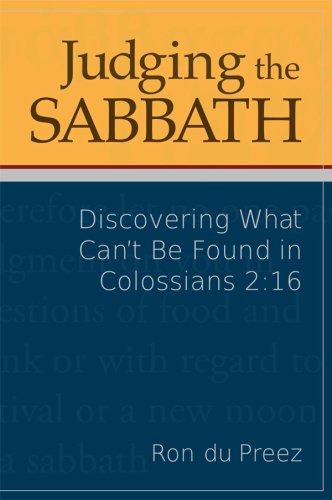Judging the Sabbath: Discovering What Can’t Be Found in Colossians 2:16
Written by Ron du Preez Reviewed By Jason C. MeyerRon du Preez has a ThD in theological ethics from the University of South Africa, a DMin in missions from Andrews University, and is currently a PhD candidate in New Testament Studies at the University of Western Cape. He has taught theology and ethics in colleges and universities in North America and Africa. The clearest statement of the author’s thesis is that “the ‘sabbath’ of Colossians 2:16 must necessarily be understood to refer to the ceremonial sabbaths of the ancient Hebrew religion, and not to the seventh-day Sabbath enshrined explicitly in the Decalogue” (p. 89).
The author develops his case in two parts. He writes the first part (chs. 1–9) for all readers and the second part (chs. 10–14) for more technical readers. Chapter one is a history of interpretation of Col 2:16. Chapter two analyzes the 111 occurrences of šabbāt in the Hebrew Bible and provides linguistic markers for distinguishing the different types of sabbaths. Specific terms (keep, the, day, holy, My) signal a reference to the Seventh-Day Sabbath, while other terms (afflict, weeks, of the land, her/its/she, your) show that another Sabbath is in view (pp. 19–21). Chapter three challenges the claim that the LXX uses the phrase sabbata sabbatōn as a designation for the ceremonial sabbaths. Chapter four examines the sixty-nine uses of “sabbath” (sabbaton or sabbata) in NT Greek. Chapter five surveys the use of šabbāt and sabbata in relation to the ceremonial sabbaths of the ancient Jewish calendar (i.e., the Day of Atonement, the Day of Trumpets, and the Sabbatical Years).
Chapter six surveys and calls into question the scholarship concerning the calendar sequence and exegesis used to support the common “yearly-monthly-weekly” interpretive paradigm of most commentators. Chapter seven examines the use of the Hebrew hag and the Greek equivalent heortē in relation to the Hebrew and Greek terms for “sabbaths.” Chapter eight looks at the immediate context of Col 2:16 and how the ceremonial sabbaths are a shadow of things to come. Chapter nine summarizes part one.
Chapter ten begins part two of the study with a look at Paul’s use of the Old Testament. Chapter eleven surveys the connections between Col 2:16 and Hos 2:11. Chapter twelve examines the chiastic parallelisms in Hosea and how this awareness influences one’s interpretation of Hos 2:11. Chapter thirteen looks at the literary, structural, and grammatical factors that support his reading of Col 2:16 in relation to Hos 2:11. Chapter fourteen offers a concluding summary. He also includes four appendixes.
This book is perhaps the best defense to date of a Sabbatarian perspective concerning Col 2:16. Interpreters of this crucial text cannot simply dismiss du Preez’s case without taking time to interact with his thesis and his arguments. The book has a logical layout that aids in the development of the thesis. It is also user-friendly in the sense that the author is sensitive to the needs of both technical and non-technical readers.
Though this book is a vigorous defense of the Sabbatarian reading, the present reviewer would classify it as a vigorous defense of a very weak position. There is simply too much stacked against this reading to make a successful defense of it. The author acknowledges the challenge of ascribing a ceremonial meaning to sabbatōn in Col 2:16 (pp. 41–42). His proposed reading is rare to say the least; it is the only alleged example of this meaning out of sixty-nine occurrences.
Furthermore, the reader sometimes will sense that the author is guilty of special pleading or elaborate exegetical gymnastics in order to defend his reading. For example, large segments of the book tackle the issue of identifying the Old Testament parallels behind Col 2:16. His chapter on the use of the Old Testament in Paul claims that Hosea is the obvious candidate because Paul quotes Hosea three times and alludes to it once, while he only alludes to Ezekiel three times and never utilizes Nehemiah or Chronicles (pp. 100–101). The present reviewer questions the minimalistic nature of these statistics and this overall methodology.
The author engages in these comparisons because he sets his sights on dismissing the traditional “yearly, monthly, weekly” interpretive scheme for the phrase “festival or a new moon or a Sabbath” (Col 2:16 esv). He observes that eighty-eight of the ninety-two commentaries he surveys (from 1861 to 2005) defend the yearly-monthly-weekly sequential reading of Colossians 2:16 (p. 56). The traditional reading frequently appeals to Old Testament precedents for this sequence in eight passages (Num 28–29; 1 Chr 23:29–31; 2 Chr 2:4; 8:12–13; 31:3; Neh 10:33; Ezek 45:17; Hos 2:11). The author dismisses the first seven passages as true parallels because they have four or five items in the sequence instead of three (p. 59, 63). Chapter 11 argues that only Hos 2:11 is a real parallel for Col 2:16 because it consists of three items in the same sequence and has similar semantic markers (see his six reasons on p. 106).
This analysis is problematic for three reasons. First, the author does not sufficiently take Lev 23:2 into account. Here the Hebrew term for “appointed times” (moed) serves as an inclusive term for the wider Jewish system, which includes the Seventh-Day Sabbath (Lev 23:3). Second, the inclusive nature of “all her appointed times” (moed) in Hos 2:11 could show that God will put an end to the wider Jewish system of Lev 23, which includes the Seventh-Day Sabbath. Third, it is questionable to assume that Paul could not have multiple parallels in mind in Col 2:16. Why does an additional item in the sequence eliminate similar texts from consideration?
Jason C. Meyer
Jason C. Meyer
Bethlehem College and Seminary
Minneapolis, Minnesota, USA
Other Articles in this Issue
I didn’t come from an Evangelical home, and though he never told me outright, I’m sure my father never wanted me to become a pastor...
Does Baptism Replace Circumcision? An Examination of the Relationship between Circumcision and Baptism in Colossians 2:11–12
by Martin SalterReformed paedobaptists frequently cite Col 2:11–12 as evidence that baptism replaces circumcision as the covenant sign signifying the same realities...
New Commentaries on Colossians: Survey of Approaches, Analysis of Trends, and the State of Research
by Nijay GuptaNew Testament scholarship in its present state is experiencing a time of abundance, especially with respect to biblical commentaries of every shape, length, level of depth, theological persuasion, intended audience, and hermeneutical angle...
It might seem odd to write an editorial for a theological journal on the topic of not doing theology and how important that can be; and, indeed, perhaps it is contrarian even by my own exacting standards...
Most readers of Themelios will be aware that the word “perfectionism” is commonly attached in theological circles to one subset of the Wesleyan tradition...







